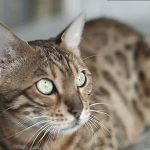As cat lovers, we all want our furry companions to live long and happy lives. But have you ever wondered which breed of cat has the shortest lifespan? It’s not a topic that brings joy to our hearts, but it’s one that deserves attention nonetheless.
In this blog post, we’ll explore which breeds of cats tend to have shorter lifespans. We’ll also dive into the factors that contribute to a cat’s lifespan and what owners can do to help their feline friends live longer.
Whether you’re considering bringing a new kitty into your home or already have a beloved feline friend, understanding the lifespan of different breeds is crucial. So let’s get ready to learn about the heartbreaking truth behind short-lived cats and how we can help our furry friends live their best lives.
Get ready for an informative and insightful journey into the world of cat breeds and their lifespans. Let’s dive in together.
Factors that Impact a Cat’s Lifespan
A cat’s genetics, environment, and lifestyle choices all play a crucial role in determining how long they will live. Let’s delve deeper into these factors and explore ways to ensure your feline friend lives a healthy and happy life.
Genetics are an essential factor in a cat’s lifespan. Some breeds are more susceptible to certain health issues that can decrease their life expectancy. Identifying these risks early on and monitoring for signs of illness can help prolong your cat’s life. For instance, Siamese cats are prone to heart disease, while Persian cats are more likely to develop kidney disease. However, mixed-breed cats tend to have fewer genetic health issues and may live longer.
The environment where a cat lives also has a significant impact on their lifespan. Indoor cats typically live longer than outdoor cats due to reduced exposure to potential hazards such as traffic accidents, animal attacks, and diseases. Although keeping your cat indoors is the best way to protect them from harm, it’s essential to provide them with mental stimulation and opportunities for exercise.
Maintaining a healthy lifestyle through proper diet and exercise is also crucial for a cat’s longevity. Feeding your cat high-quality food that meets all their nutritional requirements is vital for good health. Overfeeding or feeding inappropriate foods can lead to obesity and related health problems that can shorten a cat’s lifespan.
Exercise is equally essential for maintaining good health and longevity in cats. Regular physical activity helps keep cats at a healthy weight and reduces the risk of obesity-related health problems. Exercise also keeps cats mentally stimulated, preventing behavior problems that may lead to stress-related health issues.
Finally, access to medical care is crucial for ensuring a cat’s long-term health. Regular check-ups with a veterinarian can help identify any health issues early on before they become more severe and potentially life-threatening.
Breeds That Are Prone to Health Conditions
Every breed has its unique set of health concerns, and some breeds are more susceptible to certain health issues than others. By staying informed and taking proactive measures, you can help your furry companion live their best life. So, let’s dive into the breeds that are prone to health conditions.
Firstly, Persians and Himalayans have flat faces and short snouts – cute features that make them vulnerable to dental problems such as gum disease and tooth decay. Chewing food can be difficult for them, so keeping an eye on their dental health is crucial.
Next up are the Siamese cats. These beautiful felines are predisposed to bronchial asthma, a respiratory condition that can lead to breathing difficulties and even be fatal if left untreated. It’s essential to seek veterinary care if you notice any signs of respiratory distress in your Siamese cat.
Burmese cats are also prone to certain health issues such as hypokalemia, a condition where the cat has low potassium levels in their blood. This can lead to muscle weakness, heart problems, and even death if not treated promptly. Ensuring your Burmese cat’s potassium levels are monitored and seeking veterinary care if needed is essential.
Lastly, Bengal cats are prone to hypertrophic cardiomyopathy (HCM), a heart condition that affects the heart muscles. HCM can cause thickening of the heart muscle walls, leading to reduced blood flow and eventually heart failure. Keeping an eye on your Bengal’s heart health and seeking veterinary care if needed is vital.
Outdoor Cats and Their Shorter Lifespans
Outdoor cats are known to have a shorter lifespan compared to their indoor counterparts. As a cat expert, I am frequently asked about the reasons behind this phenomenon.
The answer is simple: outdoor cats are exposed to a wide range of dangers, including accidents, fights with other animals, and exposure to diseases. They may also be more susceptible to getting lost or stolen if they do not have proper identification.
Studies suggest that the average lifespan of an outdoor cat is around 2-5 years, while indoor cats can live up to 15-20 years or more. However, it is important to note that this can vary depending on the breed of cat and their individual circumstances. For instance, Siamese cats are known to have a shorter lifespan compared to other breeds, with an average lifespan of around 8-12 years.
As a cat owner, it is crucial to take necessary precautions if you allow your cat to go outside. One of the most important things to do is ensuring that your cat is up-to-date on their vaccinations and regularly visits the vet for check-ups. Providing proper shelter and safe areas for your cat can also help reduce risks and increase their lifespan.
It is also essential to consider your cat’s personality and behavior before allowing them outdoors. Some cats may be better suited for indoor life and may require more mental stimulation and playtime indoors.
The Benefits of an Indoor Life for Cats
Keeping our cats indoors can be the best choice for their health and safety. In fact, there are many benefits to an indoor life for cats that make it worth considering.
First and foremost, keeping your cat indoors can increase their lifespan by an average of 3-4 years. This is due to the avoidance of outdoor risks like traffic accidents, predators, and diseases. By keeping them inside, we can protect them from harm and ensure they live a long and happy life.

Another significant benefit of keeping your cat indoors is the prevention of obesity. Indoor cats tend to be less active than their outdoor counterparts, which can lead to weight gain and health issues. However, providing indoor cats with toys and activities that encourage exercise and playtime can prevent obesity and keep them healthy.
Additionally, indoor life can prevent behavioral problems in cats such as scratching furniture or spraying urine. Cats who are kept indoors are also less likely to develop anxiety or aggression towards other animals. By creating a stimulating indoor environment with plenty of toys and hiding places, we can provide our cats with the mental stimulation they need.
Indoor life also provides protection from diseases that outdoor cats may be exposed to. By limiting exposure to other cats and wildlife, we can reduce the risk of infections and illnesses that could harm our feline friends.
Lastly, keeping our cats inside gives us peace of mind knowing that they are safe and secure in their home environment. We don’t have to worry about them getting lost or injured while exploring outside.
Siamese Cats and Their Shorter Lifespans
With their striking blue eyes and sleek bodies, it’s no wonder that Siamese cats are one of the most popular breeds in the world. However, as much as we adore these furry felines, it’s important to understand why they have shorter lifespans compared to other breeds.
One of the main culprits is their predisposition to certain health issues. Respiratory problems, dental disease, heart disease, and cancer are all common ailments that affect Siamese cats more often than other breeds. To combat this, owners should schedule regular check-ups with a veterinarian to catch any health issues early on.
Furthermore, their breeding history also plays a role in their shorter lifespan. Breeders often bred closely related cats to create a more distinct appearance, which resulted in genetic issues that can impact their health and lifespan.
However, despite these challenges, there are steps owners can take to help their Siamese cats live longer, healthier lives. A nutritious diet, regular exercise, and mental stimulation are all essential components of a healthy lifestyle for any cat breed. Additionally, keeping them indoors can protect them from outdoor hazards like predators, traffic accidents, and diseases.
Persian Cats and Their Shorter Lifespans
Persian cats are a breed that is adored by many. With their long and luscious fur, expressive eyes, and gentle nature, it’s no wonder they are one of the most popular cat breeds in the world. However, despite their popularity, Persian cats have been known to have shorter lifespans compared to other felines.
On average, Persian cats live for about 12-15 years. This lifespan is relatively short compared to breeds such as Siamese or Maine Coon cats that can live up to 20 years or longer. Several factors contribute to their shorter lifespan.
Genetics is one significant factor that affects the lifespan of Persian cats. They are more prone to genetic health issues that can cause severe harm, such as kidney disease. This illness is a leading cause of death among older cats and is more common in Persian cats. Additionally, their flat faces can cause respiratory problems that can shorten their lifespan.
Another factor that plays a crucial role in the lifespan of Persian cats is the care they receive. They require daily grooming to maintain their fur’s cleanliness and prevent matting, which can lead to skin infections and other health problems. Furthermore, these cats are also prone to obesity, which can significantly shorten their lifespan if they don’t receive proper diet and exercise.
As a responsible pet owner, it’s essential to be aware of these potential health issues and take preventative measures to ensure our furry friends live long and healthy lives. Regular vet check-ups, a balanced diet, plenty of exercise, and proper grooming are all vital components of ensuring the longevity of Persian cats.
Himalayan Cats and Their Shorter Lifespans
These beautiful felines are known for their striking blue eyes and long, fluffy hair, but it’s essential to understand that they have a shorter lifespan compared to other breeds. As an expert on this topic, I’ve compiled some research notes to explain the factors that contribute to this reality.
Genetics play a crucial role in the lifespan of Himalayan cats. Unfortunately, these cats are prone to several health issues, including kidney disease, respiratory problems, and heart conditions. These health problems can significantly impact their quality of life and lead to premature death. However, as a responsible pet owner, you can take proactive measures such as regular vet check-ups and a healthy diet to minimize the risk of these health issues.
Aside from genetics, lifestyle is another crucial factor that can impact the lifespan of Himalayan cats. These felines tend to be more sedentary and may be prone to obesity if not provided with proper exercise and a balanced diet. Obesity can lead to various health problems such as diabetes, joint issues, and heart disease, which can ultimately shorten a cat’s lifespan.
As a Himalayan cat owner, it’s essential to take preventative measures to ensure your pet lives a long and healthy life. Regular vet check-ups are vital, as they can detect any underlying health issues early on. Additionally, providing your pet with a healthy diet and opportunities for exercise is crucial in preventing obesity-related health problems.
To summarize, here are some key takeaways for potential Himalayan cat owners:
- Himalayan cats have a shorter lifespan compared to other breeds due to genetics and lifestyle factors.
- Regular vet check-ups and a healthy diet can help minimize the risk of health issues.
- Providing your pet with exercise opportunities is crucial in preventing obesity-related health problems.
Ragdoll Cats and Their Shorter Lifespans
Ragdoll cats are a well-loved breed of feline for their affectionate nature and docile personalities. However, it’s important to note that they have a shorter lifespan compared to other cat breeds. On average, a Ragdoll cat can live up to 12-16 years, which is relatively short in comparison to other breeds that can live up to 20 years or more.
So why do Ragdoll cats have shorter lifespans? There are several factors at play here. Firstly, their size plays a significant role. Ragdolls are a large breed, and as such, their organs and joints have to work harder to sustain their bodies. This puts a strain on their overall health and can contribute to a shorter lifespan. Additionally, larger cats may be more prone to health issues such as heart disease and kidney problems.
Another factor that may contribute to the shorter lifespan of Ragdoll cats is their breeding history. The breed was developed in the 1960s by breeding a white Persian cat with a Birman or Siamese cat. While this created a beautiful and unique breed, it also resulted in some genetic health issues that can impact their lifespan.
As responsible pet owners, it’s important to take steps to ensure our furry friends live their best life despite their shorter lifespan. Regular vet check-ups can catch any health issues early on, allowing for prompt treatment and management. A healthy diet and exercise routine can also go a long way in keeping your Ragdoll cat in tip-top shape.
Despite their shorter lifespans, Ragdoll cats remain beloved pets for many families. They are known for their loving personalities and make excellent companions. It’s crucial for pet owners to be aware of potential health issues and take proactive measures to ensure the well-being of their furry friends.
Conclusion
As cat lovers, we all want our furry companions to live long and happy lives. However, it’s important to understand that certain breeds of cats have shorter lifespans due to a variety of factors. Genetics, environment, lifestyle choices, and access to medical care all play crucial roles in determining how long a cat will live.
If you own a Siamese, Persian, Himalayan, or Ragdoll cat, it’s important to be aware that they are more prone to health issues that can decrease their life expectancy. Regular vet check-ups and a healthy diet can help minimize the risk of these health issues. Additionally, keeping your cats indoors can protect them from outdoor hazards like predators, traffic accidents, and diseases.
It may be heartbreaking to think about our beloved feline friends having shorter lifespans. However, being informed and taking proactive measures can help prolong their lives. By providing them with proper care and attention, we can ensure they live their best lives possible.
So, let’s continue to love and cherish our furry companions while keeping them healthy and happy for as long as possible.







